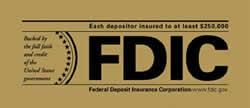By Casey Bond
October 8, 2017
You might have seen it mentioned on your bank’s website or in a commercial, but what is the FDIC? The Federal Deposit Insurance Corporation is an independent government insurance agency that protects customers’ deposits in banks and thrift institutions in case of bank failures. FDIC bankers’ insurance covers all deposit accounts, including checking, savings, certificates of deposit and money market accounts up to $250,000 per account.
The National Credit Union Share Insurance Fund is similar to the FDIC in that it protects individual accounts up to $250,000. One difference with NCUA insurance, however, is that it covers regular shares and share draft accounts which are specific to credit unions and do not exist at banks. In addition, the $250,000 deposit insurance limit applies to the total deposits with one institution unlike the FDIC which is $250,000 per account.
Keep reading to find out the details of NCUA vs. FDIC insurance and fully understand if and how your money is protected. Find out if your account is covered whether you keep your money with a credit union or a bank.

From single accounts to trust accounts, here’s a list of the specific types of accounts that are FDIC insured and their coverage limits:
| Type of Account | Description of Account | Coverage Limit |
|---|---|---|
| Single Account | Deposit account – such as a checking account, savings account, CD, money market account or business account – with one owner and no beneficiaries | $250,000 per owner |
| Certain Retirement Account | Account Self–directed retirement account in which owner can direct how much money is invested, such as an IRA or 401k | $250,000 per owner |
| Joint Account | Deposit account with two or more owners but no beneficiaries | $250,000 per co–owner |
| Revocable Trust Account | Deposit account with at least one owner with one or more beneficiaries | Owner insured $250,000 for each unique beneficiary designated |
| Irrevocable Account | Deposit account held in connection with an irrevocable trust established by statute or a written trust agreement | $250,000 for the trust, but more coverage is available |
| Employee Benefit Plan Account | Deposit of pension, defined benefit plan or other employee benefit plan that’s not self directed | $250,000 for the non-–contingent interest of each plan participant |
| Corporation, Partnership or unincorporated Association Account |
Deposit account owned by a corporation, partnership or unincorporated association, such as for-profit and not–for–profit organizations |
$250,000 per corporation, partnership or unincorporated association |
| Government Account | Deposit account owned by the U.S., any state, county, municipality, the District of Columbia, Puerto Rico or an Indian tribe |
$250,000 per official custodian |
Source: Federal Deposit Insurance Corporation
The FDIC insures qualifying accounts up to the limit per depositor, per institution. That means if you hold two accounts at one bank, both with balances that meet the maximum insurance amount, only half of your money is protected.
Just because your account has bank insurance, however, does not mean all of your accounts are insured –even if they’re under $250,000. The FDIC will not insure other financial products that might be offered by your bank.
Here’s a simple guide to help you remember what’s FDIC insured and what’s not FDIC insured:
Checking accounts
Savings accounts
Money market deposit accounts
Certificates of deposit and other time deposits
Negotiable order of withdrawal accounts
Money orders
Cashier’s checks
Annuities
Mutual Funds
Stocks
Bonds
Government securities
Municipal securities
U.S. Treasury bills, bonds or notes
Source: Federal Deposit Insurance Corporation
Additionally, only your principal balance and accrued interest that remain under the limit are guaranteed. If any interest you gain exceeds the maximum insurance amount, and something goes wrong with your bank, your money is vulnerable. So, it’s important to keep an eye on your bank account balance.
Some accounts have special insurance rules that apply to them specifically as well which is why it’s crucial to check with your bank to find out exactly how much of your money is covered and which accounts aren’t.
You might be surprised to learn that banks aren’t required to have FDIC insurance. Even so, many banks choose to be covered because uninsured banks can’t compete with those that offer full protection.
If you’re unsure whether your bank provides FDIC insurance, call your bank or visit its website. Usually, bank websites indicate on the bottom of the home page if it’s a member of the FDIC. Here is a list of 20 FDIC insured banks–but there are plenty of others:
1. JPMorgan Chase
2. Capital One
3. Ally Bank
4. TD Bank
5. HSBC
6. BB&T
7. State Street
8. J.P. Morgan
9. Bank of America
10. SunTrust
11. BNY Mellon
12. The Huntington National Bank
13. Charles Schwab
14. PNC Bank
15. Citibank
16. KeyBank
17. Wells Fargo
18. U.S. Bank
19. PNC Bank
20. Bank One Corporation
Credit unions are not FDIC insured. But this fact doesn’t make them less safe. The NCUA, much like the FDIC, is an independent federal agency. It’s charged with chartering and regulating federal credit unions in addition to insuring deposits at federal credit unions and administering the National Credit Union Share Insurance Fund.
 The National Credit Union Administration
The National Credit Union AdministrationNow that you know what FDIC insurance is, what is NCUA insurance? The insurance coverage the NCUA provides through the NCUSIF is practically the same as the FDIC. Individual accounts are protected up to $250,000.
One difference with NCUA insurance, though, is that it covers regular shares and share draft accounts which are specific to credit unions and do not exist at banks. Also, the $250,000 limit applies to the total deposits with one institution.
To see which of your accounts are covered by the NCUSIF and which ones can come with additional or separate coverage, check out the following table below:
| Accounts With Basic NCUSIF Coverage | Accounts That Offer Additional or Separate NCUSIF Coverage |
|---|---|
| Savings accounts | Retirement accounts—Traditional IRAs, Roth IRA, KEOGH retirement accounts |
| Checking accounts | Joint accounts |
| Money market accounts | Revocable trusts |
| Share certificates | Irrevocable trusts |
Source: National Credit Union Administration
Always confirm with your credit union which accounts come with NCUA coverage. Like the FDIC, the NCUA does not insure money invested in:
Only federal credit unions are automatically covered by NCUA insurance. Some state chartered institutions are not insured by the NCUA, so they don’t offer the same protection against credit union failure. Even so, state chartered credit unions might still elect to be NCUA insured, and many are.
To find out if your accounts are insured, call your credit union or visit its website. Federally insured credit unions are required to display the official NCUA insurance sign within their branches and on their websites.
Here is a list of 20 NCUA insured credit unions, but there are more:
1. Navy Federal Credit Union
2. State Employees Credit Union
3. PenFed Credit Union
4. BECU Credit Union
5. Schools First Federal Credit Union
6. Golden1 Credit Union
7. Security Service Federal Credit Union
8. Alliant
9. First Tech Federal Credit Union
10. Star One Credit Union
11. America’s First Federal Credit Union
12. San Diego County Credit Union
13. Suncoast Credit Union
14. DCU
15. RBFCU
16. Bethpage Federal Credit Union
17. Alaska USA
18. VyStar
19. American Airlines Credit Union
20. ESL Federal Credit Union
